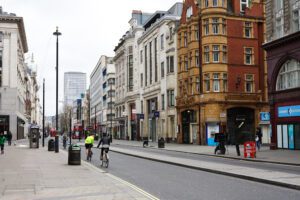
Office workers in central London are spending on average 2.3 days a week in the workplace, according to a report that warns against a wholesale switch to working from home.
The thinktank Centre for Cities carried out polling of office workers in the capital and found they were spending 59% of the time in their workplace compared with pre-Covid levels.
The study showed the most common working pattern was two days a week, accounting for 31% of respondents. Almost half of workers were in the office more often than that, however – three, four or five days a week.
The research also found three-quarters of employers had set a minimum number of days that staff have to be in the office.
But the report, entitled Office Politics: London and the Rise of Home Working, warns that, despite the upfront benefits for staff in terms of better work-life-balance and less commuting, there may be longer-term costs for the capital in terms of lost productivity.
“High-skilled activity being clustered within the centre of big cities is important. There’s a productivity benefit to that happening,” said the report’s lead author, Paul Swinney.
He pointed to firms’ ability to hire staff from a local pool of high-skilled labour, as well as the benefits within companies of the creativity that comes with face-to-face interaction, and the on-the-job learning that takes place between colleagues.
“The evidence is unclear as to whether a two-day week or a three-day week is adequate to harness those benefits – but we should be alive to the fact that there may be a productivity hit from this sort of thing, rather than blithely assuming that all is fine because we’re focused on the short term rather than the long term,” he said.
Younger workers are more likely to come into the office, which Swinney suggested could be because of the benefits from learning, as well as the likelihood that they have less space at home given London’s eye-watering property prices.
The report, supported by the Eastern City business improvement district, which includes firms in that part of London, calls for policies to encourage workers to return.
These could include scrapping peak-time fares on a Friday morning to tempt commuters, and launching a public information campaign to underline the benefits of office life.
Prof Nick Bloom, an expert in hybrid working at Stanford University in the US, found recently that employees value the ability to work from home as equivalent to an 8% pay rise.
The Centre for Cities also warned against an approach that assumes current patterns are permanent – such as speeding up the conversion of commercial property into flats.
“We need to be careful that we don’t rush into setting lots of policies in the short term that then cause problems in terms of trying to unpick in the longer term,” Swinney said.
Data from Google for late 2022 suggested the return to work in London had happened more gradually than in other big UK cities – with public transport use in Greater Manchester just 7% lower than pre-pandemic, against 14% in the capital.
Working patterns have increasingly become a political issue, with some rightwingers including the former cabinet minister Jacob Rees-Mogg bemoaning the tendency of civil servants to work from home.
The chancellor, Jeremy Hunt, used his speech at the British Chambers of Commerce conference recently to warn against the loss of “water cooler moments” when colleagues encounter each other at work.
Labour by contrast has suggested it could legislate to give employees the right to work from home where practicable.
Many jobs, from hairdressing to social care, do not lend themselves to distance working, and the Trades Union Congress has warned of a class divide, with desk-based workers increasingly enabled to work from home.
Read more:
Staff work in central London offices for 2.3 days a week, study finds






